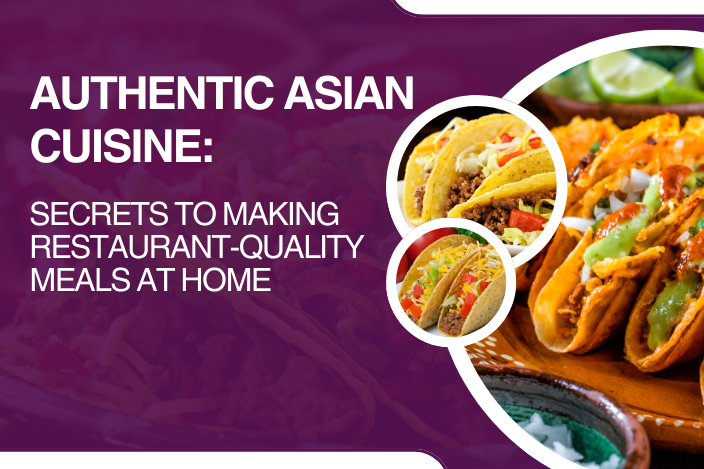Asian cuisine is revered for its bold flavours, intricate techniques, and delicate balance of taste and texture. Whether it’s the fragrant spices of Thai curries, the umami depth of Japanese ramen, or the comforting warmth of Chinese dumplings, Asian food has captivated palates worldwide.
However, many home cooks struggle to replicate the restaurant-quality experience at home. The good news? By using the right ingredients, perfecting fundamental cooking methods, and following a few expert tips, you can create authentic Asian dishes in your kitchen.
This guide will walk you through essential Asian ingredients, traditional cooking techniques, signature recipes, and common pitfalls to avoid. Whether you’re a novice or an experienced cook, these insights will help you master the art of Asian cuisine at home.
(Looking to source authentic Asian ingredients in the UK? Check out JK Foods UK, which is one of the leading oriental food importers in the UK.)
Understanding Essential Asian Ingredients
1. The Backbone of Asian Cooking: Key Sauces and Condiments
Soy Sauce (Light & Dark)
- Light Soy Sauce – Saltier and more liquid, ideal for seasoning and marinades.
- Dark Soy Sauce – Richer, slightly sweet, and adds depth to braised dishes.
Fish Sauce
- A fermented ingredient key to Thai, Vietnamese, and Filipino cooking, it adds a deep umami punch to curries, stir-fries, and dipping sauces.
Miso Paste
- White Miso (Shiro Miso) – Mild and slightly sweet, used in soups and dressings.
- Red Miso (Aka Miso) – Stronger and saltier, perfect for stews and glazes.
2. Essential Pantry Staples
✅ Rice & Noodles: Jasmine rice, sushi rice, egg noodles, and rice noodles.
✅ Vinegars & Oils: Rice vinegar for tangy balance, black vinegar for deep flavour, and sesame oil for finishing dishes.
✅ Spices & Aromatics: Star anise, Sichuan peppercorns, lemongrass, and fresh ginger.
(Looking for a reliable ethnic food supplier? Find out why JK Foods UK is the go-to ethnic food supplier.)
Mastering Cooking Techniques for Authentic Flavours
1. Stir-Frying: The Heart of Asian Cuisine
✅ Use a wok – It distributes heat evenly, allowing for quick and high-heat cooking.
✅ Preheat before adding oil – This prevents food from sticking.
✅ Cook in small batches – Avoid overcrowding to maintain crisp textures.
Best Dishes to Try:
- Classic Beef & Broccoli Stir-Fry
- Pad See Ew (Thai Stir-Fried Noodles)
2. Steaming for Healthy, Delicate Flavours
- Best for dumplings, fish, and vegetables.
- Use a bamboo steamer for even cooking.
- Keep the water simmering, not boiling, for gentle steaming.
3. Braising for Deep, Complex Flavours
- Sear proteins first for caramelisation.
- Simmer in a flavourful broth.
- Allow sauces to reduce for a richer taste.
Best Dishes to Try:
- Red-Braised Pork Belly (Hong Shao Rou)
- Korean Galbi Jjim (Braised Short Ribs)
(Need inspiration for Japanese ingredients? Check out this guide to top Japanese food importers in the UK.)
Signature Asian Dishes You Can Make at Home
1. Pad Thai (Thailand)
- Sweet, tangy, and nutty stir-fried noodles with prawns, tofu, and crunchy peanuts.
2. General Tso’s Chicken (China)
- Crispy fried chicken in a glossy sweet and spicy sauce.
3. Sushi Rolls (Japan)
- Homemade sushi with fresh salmon, avocado, and cucumber wrapped in nori.
4. Bibimbap (Korea)
- Colourful rice bowl with spicy gochujang sauce, sautéed vegetables, and fried egg.
5. Vietnamese Pho (Vietnam)
- Aromatic broth with beef, rice noodles, and fresh herbs.
Plating and Presentation: The Art of Serving Asian Food
Key Tips for Stunning Presentation:
✔ Use traditional serveware – bamboo steamers, ceramic ramen bowls, and lacquered bento boxes.
✔ Balance colours – bright chillies, green herbs, and golden sesame seeds.
✔ Stack and layer ingredients – adds height and dimension.
✔ Garnish purposefully – use edible elements like coriander, spring onions, and sesame seeds.
(Looking for authentic Japanese tableware? Discover the best importers in the UK here.)
Common Mistakes to Avoid When Cooking Asian Food
🚫 Overcrowding the Wok – Leads to steaming instead of stir-frying.
🚫 Skipping the Marinade – Asian meats need proper marination for depth of flavour.
🚫 Using the Wrong Soy Sauce – Light soy for seasoning, dark soy for colour.
🚫 Overcooking or Undercooking Rice & Noodles – Always rinse rice and slightly undercooked noodles for stir-fries.
FAQs About Cooking Authentic Asian Cuisine
Where can I buy authentic Asian ingredients in the UK?
- Try JK Foods UK for high-quality imported products.
Do I need a wok to make authentic Asian food?
- A wok is ideal, but a deep non-stick pan can work in a pinch.
Why doesn’t my stir-fry taste like restaurant food?
- Use high heat, cook in batches, and add sauce.
What’s the secret to fluffy rice?
- Rinse before cooking and use the correct water-to-rice ratio.
Conclusion: Mastering Authentic Asian Cuisine at Home
By following these techniques, ingredient tips, and cooking secrets, you’ll be able to recreate restaurant-quality Asian dishes with confidence. Remember, Asian cooking is about balance, bold flavours, and fresh ingredients—so don’t be afraid to experiment and refine your skills!
Now, grab your wok and start cooking! 🍜🥢
(Looking for high-quality Asian ingredients in the UK? JK Foods UK has a vast selection of authentic products!)

